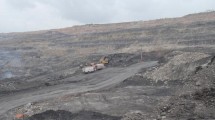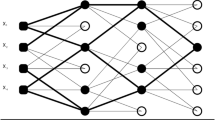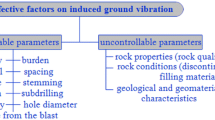Abstract
Mines, quarries, and construction sites face environmental damages due to blasting environmental impacts such as ground vibration and air overpressure. These phenomena may cause damage to structures, groundwater, and ecology of the nearby area. Several empirical predictors have been proposed by various scholars to estimate ground vibration and air overpressure, but these methods are inapplicable in many conditions. However, prediction of ground vibration and air overpressure is complicated as a consequence of the fact that a large number of influential parameters are involved. In this study, a hybrid model of an artificial neural network and a particle swarm optimization algorithm was implemented to predict ground vibration and air overpressure induced by blasting. To develop this model, 88 datasets including the parameters with the greatest influence on ground vibration and air overpressure were collected from a granite quarry site in Malaysia. The results obtained by the proposed model were compared with the measured values as well as with the results of empirical predictors. The results indicate that the proposed model is an applicable and accurate tool to predict ground vibration and air overpressure induced by blasting.
















Similar content being viewed by others
References
Adhikari R, Agrawal RK (2011) Effectiveness of PSO based neural network for seasonal time series forecasting. In: Proceedings of the Indian international conference on artificial intelligence (IICAI), Tumkur, India, pp 232–244
Baker WE, Cox PA, Kulesz JJ, Strehlow RA, Westine PS (1983) Explosion hazards and evaluation. Elsevier Science, Amsterdam
Basheer IA, Hajmeer M (2000) Artificial neural networks: fundamentals, computing, design, and application. J Microbiol Methods 43:3–31
Basu D, Sen M (2005) Blast induced ground vibration norms—a critical review. National seminar on policies statutes and legislation in Mines Kharagpur, India, pp 112–113
Bhandari S (1997) Engineering rock blasting operations. AA Balkema, Rotterdam
Bounds DG, Lloyd PJ, Mathew B, Waddell G (1998) A multilayer perceptron network for the diagnosis of low back pain. In: IEEE international conference on neural networks, pp 481–489
Bureau of Indian Standard (1973) Criteria for safety and design of structures subjected to underground blast. ISI Bull, IS-6922
Cengiz K (2008) The importance of site-specific characters in prediction models for blast-induced ground vibrations. Soil Dyn Earthq Eng 28:405–414
Clerc M, Kennedy J (2002) The particle swarm explosion, stability, and convergence in a multi-dimensional complex space. IEEE Trans Evolut Comput 6:58–73
Davies B, Farmer IW, Attewell PB (1964) Ground vibrations from shallow sub-surface blasts. Eng Lond 217:553–559
Diamantidis NA, Karlis D, Giakoumakis EA (2000) Unsupervised stratification of cross-validation for accuracy estimation. Artif Intell 116:1–16
Douglas E (1989) An investigation of blasting criteria for structural and ground vibrations. Master Thesis, Ohio University
Dowding CH (1985) Blast vibration monitoring and control. Prentice-Hall, Englewoods Cliffs, pp 288–290
Dowding CH (ed) (2000) Construction vibrations. pp 204–207
Dreyfus G (2005) Neural Networks: methodology and application. Springer, Berlin, Heidelberg
Duvall WI, Petkof B (1959) Spherical propagation of explosion of generated strain pulses in rocks. USBM, RI-5483
Duvall WI, Johnson CF, Meyer AVC (1963) Vibrations from blasting at Iowa limestone quarries. USBM Report Investigation, p 28
Eberhart RC, Kennedy J (1995) A new optimizer using particle swarm theory. In: Proceedings of the sixth international symposium on micro machine and human science. IEEE, pp 39–43
Eberhart RC, Shi Y (1998) Evolving artificial neural networks. In: Proceedings of the international conference on neural networks and brain, pp 5–13
Eberhart RC, Shi Y (2001) Particle swarm optimization: developments, applications and resources. In: IEEE international conference on evolutionary computation, pp 81–86
Eberhart RC, Simpson PK, Dobbins RW (1996) Computational intelligence PC tools. Academic Press Professional, Boston
Ebrahimi E, Monjezi M, Khalesi MR, Jahed Armaghani D (2015) Prediction and optimization of back-break and rock fragmentation using an artificial neural network and a bee colony algorithm. Bull Eng Geol Environ. doi:10.1007/s10064-015-0720-2
Engelbrecht AP (2007) Computational intelligence: an introduction, 2nd edn. Wiley, New York
Fişne A, Kuzu C, Hüdaverdi T (2011) Prediction of environmental impacts of quarry blasting operation using fuzzy logic. Environ Monit Assess 174:461–470
Ghasemi E, Ataei M, Hashemolhosseini H (2013) Development of a fuzzy model for predicting ground vibration caused by rock blasting in surface mining. J Vib Control 19:755–770
Ghoraba S, Monjezi M, Talebi N, Moghadam MR, Jahed Armaghani D (2015) Prediction of ground vibration caused by blasting operations through a neural network approach: a case study of Gol-E-Gohar Iron Mine, Iran. J Zhejiang Univ Sci A. doi:10.1631/jzus.A1400252
Ghosh A, Daemen JK (1983) A simple new blast vibration predictor. In: Proceedings of the 24th US symposium on rock mechanics College Station, Texas, pp 151–161
Gordan B, Jahed Armaghani D, Hajihassani M, Monjezi M (2015) Prediction of seismic slope stability through combination of particle swarm optimization and neural network. Eng Comput. doi:10.1007/s00366-015-0400-7
Griffiths MJ, Oates JAH, Lord P (1978) The propagation of sound from quarry blasting. J Sound Vib 60:359–370
Gudise VG, Venayagamoorthy GK (2003) Comparison of particle swarm optimization and backpropagation as training algorithms for neural networks. In: Swarm intelligence symposium SIS’03, Proceedings of the 2003 IEEE, pp 110–117
Hajihassani M, Jahed Armaghani D, Sohaei H, Tonnizam Mohamad E, Marto A (2014a) Prediction of airblast-overpressure induced by blasting using a hybrid artificial neural network and particle swarm optimization. Appl Acoust 80:57–67
Hajihassani M, Jahed Armaghani D, Marto A, Tonnizam Mohamad E (2014b) Ground vibration prediction in quarry blasting through an artificial neural network optimized by imperialist competitive algorithm. Bull Eng Geol Environ. doi:10.1007/s10064-014-0657-x
Hopler RB (1998) Blasters’ handbook, 17th edn. International Society of Explosives Engineers, Cleveland
Hudaverdi T (2012) Application of multivariate analysis for prediction of blast-induced ground vibrations. Soil Dyn Earthq Eng 43:300–308
Hustrulid WA (1999) Blasting principles for open pit mining: general design concepts. Balkema, Rotterdam
Iphar M, Yavuz M, Ak H (2008) Prediction of ground vibrations resulting from the blasting operations in an open-pit mine by adaptive neuro-fuzzy inference system. Environ Geol 56:97–107
Jahed Armaghani D, Hajihassani M, Mohamad ET, Marto A, Noorani SA (2014a) Blasting-induced flyrock and ground vibration prediction through an expert artificial neural network based on particle swarm optimization. Arab J Geosci 7:5383–5396
Jahed Armaghani D, Hajihassani M, Yazdani Bejarbaneh B, Marto A, Tonnizam Mohamad E (2014b) Indirect measure of shale shear strength parameters by means of rock index tests through an optimized artificial neural network. Measurement 55:487–498
Kennedy J, Eberhart RC (1995) Particle swarm optimization. In: Proceedings of IEEE international conference on neural networks, Piscataway, pp 1942–1948
Khandelwal M, Kankar PK (2011) Prediction of blast-induced air overpressure using support vector machine. Arab J Geosci 4:427–433
Khandelwal M, Singh TN (2005) Prediction of blast induced air overpressure in opencast mine. Noise Vib Worldw 36:7–16
Khandelwal M, Singh TN (2006) Prediction of blast induced ground vibrations and frequency in opencast mine: a neural network approach. J Sound Vib 289:711–725
Khandelwal M, Singh TN (2009) Prediction of blast-induced ground vibration using artificial neural network. Int J Rock Mech Min Sci 46:1214–1222
Konya CJ, Walter EJ (1990) Surface blast design. Prentice Hall, Englewood Cliffs
Kosko B (1994) Neural networks and fuzzy systems: a dynamical systems approach to machine intelligence. Prentice Hall, New Delhi
Kuzu C, Fisne A, Ercelebi SG (2009) Operational and geological parameters in the assessing blast induced airblast-overpressure in quarries. Appl Acoust 70:404–411
Langefors U, Kihlstrom B (1963) The modern technique of rock blasting. Wiley, New York
Liou SW, Wang CM, Huang YF (2009) Integrative discovery of multifaceted sequence patterns by frame-relayed search and hybrid PSO-ANN. J Univ Comput Sci 15:742–764
Marto A, Hajihassani M, Jahed Armaghani D, Tonnizam Mohamad E, Makhtar AM (2014) A novel approach for blast-induced flyrock prediction based on imperialist competitive algorithm and artificial neural network. Sci World J 2014. doi:10.1155/2014/643715
McKenzine C (1990) Quarry blast monitoring: technical and environmental perspective. Quarry Manag 17:23–29
Mendes R, Cortez P, Rocha M, Neves J (2002) Particle swarms for feedforward neural network training. In: Proceedings of the international joint conference on neural networks. IEEE, pp 1895–1899
Mohamed MT (2011) Performance of fuzzy logic and artificial neural network in prediction of ground and air vibrations. Int J Rock Mech Min Sci 48:845–851
Momeni E, Jahed Armaghani D, Hajihassani M, Mohd Amin MF (2015) Prediction of uniaxial compressive strength of rock samples using hybrid particle swarm optimization-based artificial neural networks. Measurement 60:50–63
Monjezi M, Dehghani H (2008) Evaluation of effect of blasting pattern parameters on back break using neural networks. Int J Rock Mech Min Sci 45:1446–1453
Monjezi M, Ahmadi M, Sheikhan A, Bahrami M, Salimi AR (2010) Predicting blast-induced ground vibration using various types of neural networks. Soil Dyn Earthq Eng 30:1233–1236
Monjezi M, Ghafurikalajahi M, Bahrami A (2011) Prediction of blast-induced ground vibration using artificial neural networks. Tunn Undergr Space Technol 26:46–50
Monjezi M, Amini Khoshalan H, Yazdian Varjani A (2012) Prediction of flyrock and backbreak in open pit blasting operation: a neurogenetic approach. Arab J Geosci 5:441–448
Monjezi M, Hasanipanah M, Khandelwal M (2013) Evaluation and prediction of blast-induced ground vibration at Shur River Dam, Iran, by artificial neural network. Neural Comput Appl 22(7):1637–1643
Montana DJ, Davis L (1989) Training feedforward neural networks using genetic algorithms. IJCAI 89:762–767
Morhard RC (1987) Explosives and rock blasting. Atlas Powder Company, Dallas
National Association of Australian State Road Authorities (1983) Explosives in roadworks—a users guide. NAASRA, Sydney
New BM (1986) Ground vibration caused by civil engineering works. Transport and Road Research Laboratory Research Report, NO RR 53
Ozer U, Karadogan A, Kahriman A, Aksoy M (2011) Bench blasting design based on site-specific attenuation formula in a quarry. Arab J Geosci 6(3):711–721
Rafiai H, Jafari A (2011) Artificial neural networks as a basis for new generation of rock failure criteria. Int J Rock Mech Min Sci 48:1153–1159
Rafig MY, Bugmann G, Easterbrook DJ (2001) Neural network design for engineering applications. Comput Struct 79:1541–1552
Raina AK, Murthy VMSR, Soni AK (2014) Flyrock in bench blasting: a comprehensive review. Bull Eng Geol Environ. doi:10.1007/s10064-014-0588-6
Rodríguez R, Toraño J, Menéndez M (2007) Prediction of the airblast wave effects near a tunnel advanced by drilling and blasting. Tunn Undergr Space Technol 22:241–251
Rodríguez R, Lombardia C, Torno S (2010) Prediction of the air wave due to blasting inside tunnels: approximation to a ‘phonometric curve’. Tunn Undergr Sp Technol 25:483–489
Rosenthal MF, Morlock GL (1987) Blasting guidance manual. Office of Surface Mining Reclamation and Enforcement, US Department of the Interior, OSMRE, p 201
Roy PP (1993) Putting ground vibration predictors into practice. Colliery Guardian 241:63–67
Roy PP (2005) Rock blasting: effects and operations. CRC Press, Boca Raton
Segarra P, Domingo JF, López LM, Sanchidrián JA, Ortega MF (2010) Prediction of near field overpressure from quarry blasting. Appl Acoust 71:1169–1176
Settles M, Rylander B (2002) Neural network learning using particle swarm optimizers. In: Advances in information science and soft computing, pp 224–226
Shi Y, Eberhart R (1998) A modified particle swarm optimizer. In: Evolutionary computation Proceedings, 1998. IEEE World congress on computational intelligence, the 1998 IEEE international conference, pp 69–73
Simpson PK (1990) Artificial neural system: foundation, paradigms applications and implementations. Pergamon, New York
Singh DP, Sastry VR (1986) Rock fragmentation by blasting: influence of joint filling material. J Explos Eng 18–27
Singh TN, Singh V (2005) An intelligent approach to prediction and control ground vibration in mines. Geotech Geol Eng 23:249–262
Siskind DE, Stachura VJ, Stagg MS, Koop JW (1980) Structure response and damage produced by airblast from surface mining. Report of investigations 8485, United States Bureau of Mines, Washington, DC
Socha K, Blum C (2007) An ant colony optimization algorithm for continuous optimization: application to feed-forward neural network training. Neural Comput Appl 16:235–247
Specht DF (1991) A general regression neural network. Neural Netw IEEE Trans 2:568–576
Tonnizam Mohamad E, Hajihassani M, Jahed Armaghani D, Marto A (2012) Simulation of blasting-induced air overpressure by means of artificial neural networks. Int Rev Model Simul 5:2501–2506
Tsou D, MacNish C (2003) Adaptive particle swarm optimization for high-dimensional highly convex search spaces. In: Evolutionary computation, 2003. CEC’03. The 2003 congress, vol 2, pp 783–789
Van den Bergh F, Engelbrecht AP (2000) Cooperative learning in neural networks using particle swarm optimizers. S Afr Comput J 26:84–90
White TJ, Farnfield RA (1993) Computers and blasting. In: Transactions of the Institution of Mining and Metallurgy, p 102
Wiss JF, Linehan P (1978) Control of vibration and blast noise from surface coal mining. US Bureau of Mines, Research Report, Washington DC, p 103
Yang Y, Zang O (1997) A hierarchical analysis for rock engineering using artificial neural networks. Rock Mech Rock Eng 30:207–222
Acknowledgments
The authors would like to extend their appreciation to the Universiti Teknologi Malaysia for UTM Research University Grant No. 01H88 and for providing the required facilities that made this research possible.
Author information
Authors and Affiliations
Corresponding author
Rights and permissions
About this article
Cite this article
Hajihassani, M., Jahed Armaghani, D., Monjezi, M. et al. Blast-induced air and ground vibration prediction: a particle swarm optimization-based artificial neural network approach. Environ Earth Sci 74, 2799–2817 (2015). https://doi.org/10.1007/s12665-015-4274-1
Received:
Accepted:
Published:
Issue Date:
DOI: https://doi.org/10.1007/s12665-015-4274-1




